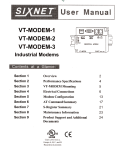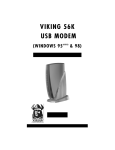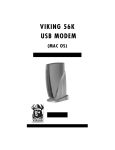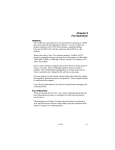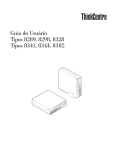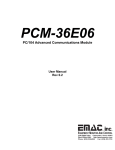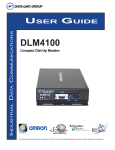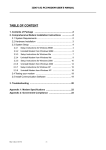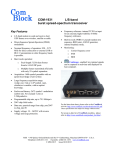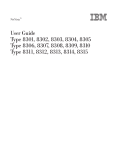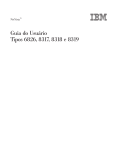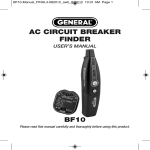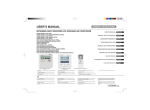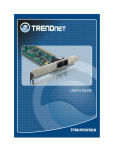Download User`s Manual
Transcript
High Performance V.90/K56Flex/V.34+/V.42bis 56K BPS Plug & Play External Voice/FAX/Data Modem With Advanced Speakerphone functions User's Manual Contents Section One - Introduction ........................... 1 Section Two - Installation ............................. 1 Section Three - AT Command Set ............... 6 Section Four - S Registers ........................ 13 Section Five - Result Codes ...................... 15 Section Six - Troubleshooting .................... 15 Section Seven - Support and Service ......... 17 Appendix A - Specifications ..................... 17 Appendix B - Notices ................................ 18 SF-1156V/R21 V1.0 The information contained in this manual has been validated at the time of this manual's production. The manufacturer reserves the right to make any changes and improvements in the product described in this manual at any time and without notice. Consequently the manufacturer assumes no liability for damages incurred directly or indirectly from errors, omissions or discrepancies between the product and the manual. All registered trademarks are the property of their respective owners. Copyright 1998 All rights reserved. No reproduction of this document in any form is permitted without prior written authorization from the Manufacturer. Section One - Introduction This 56 Kbps* Plug and Play FAX/Voice/Data Speakerphone Modem connects your computer to all popular high speed modems available today. The modem incorporates "V.90/K56Flex"(56Kbps) technology to provide increased download speeds using regular telephone lines. The modem incorporates Plug and Play for ease of installation. It features speakerphone capabilities for hands-free communication. This manual describes the hardware installation procedures for your new modem. Additional information on AT commands and S-registers is provided so that your system can be customized for a particular operating environment. *Note:V.90/K56Flex is capable of downloading at 56Kbps. However, current FCC regulations limit its speeds to 53Kbps. Section Two - Installation This section will provide step by step instructions on how to install your new 56 Kbps Voice/FAX/Data modem. Installation of this modem product is a two-step process consisting of: 1) hardware installation and, 2) communication software installation and configuration. 2.1 Unpacking Your Modem Be certain that you have all the items listed below. This package contains: ¡EA modem ¡EA modem power supply ¡EA telephone cable ¡EA User's manual ¡ESoftware for the modem ¡ESoftware user's manual 2.2 Hardware Installation Installation of this modem requires an available serial port on your computer. This is either a 25-pin or 9-pin male connector on the back of your computer. Consult the computer's manual on this topic. You will also need a properly configured serial cable. The recommended cable for IBM Compatible PCs with a 25-pin serial port is an RS232 cable with all 25 pins configured Straight-through. 1 For computers with a 9-pin serial port, use an IBM AT type (9-pin to 25-pin) RS-232 serial cable. For Macintosh Plus or newer computers, use only a high speed RS-232 serial cable that supports hardware flow control signals. Note: Exercise caution when working with any ACpowered device. Always turn the power off when connecting or disconnecting cables to or from the device. 1. Turn your computer off. 2. Plug the male end of the RS-232 modem cable into the connector marked RS-232C on the back of the modem (refer to Figure 2-1). Figure 2-1 Power Switch Power RS-232C Connector Connection Audio Jack SPK Line Phone Connection Connection MIC 3. Plug the other end of the cable into the serial port on your computer (refer to Figure 2-2). Figure 2-2 PHONE LINE MIC SPK RS-232C POWER 4. Turn the modem's power switch off. Plug the round end of the power cord into the connector marked POWER on the back of the modem. 5. Plug the transformer end of the power adapter into an AC wall outlet. 6. Connect the telephone cable from the modem's LINE “ c connector to the telephone wall jack. 2 7. Optionally, connect a telephone to the modem's PHONE connector. 8. Turn the modem on. 9. Turn your computer on. Your modem is now installed. If you are running Windows 95, continue to Section 2.3 for configuration information. Otherwise, proceed to Section 2.4 for communication software installation. 2.3 Configuring in Windows 95 2.3.1 Windows 95 Release 4.00.950 When Windows 95 starts for the first time after card installation, it detects the modem and displays the New Hardware Found dialog box. Under New Hardware Found, when asked to "Select which driver you want to install for your new hardware,"click on "Driver from disk provided by hardware manufacturer. "Click OK." The Install From Disk dialog box now instructs you to "insert the manufacturer's installation disk into the drive selected, and then click OK. "Insert the modem's driver diskette into the disk drive and type A:\ (or B:\ if inserted in drive B) in the "Copy manufacturer's files from:"box. Click "OK." Windows 95 may request its own installation disks or CD-ROM for some files. Insert the Windows 95 disks or CD-ROM as required. When all necessary files are copied, the modem is configured. Proceed to Section 2.4. 2.3.2 Windows 95 Release 4.00.950 B When Windows 95 starts for the first time after card installation, it detects the modem and displays the Update Device Driver Wizard. Insert the driver disk into the disk drive and click "Next." Windows will find the driver on the driver disk. Click "Finish." Windows 95 may request its own installa3 tion disks or CD for some files. Insert the Windows 95 disks or CD as required. Windows will now find a second device on the modem. Make sure that the driver disk is still in the disk drive and click "Next." Windows will find the second driver. Click "Finish" to complete the installation. When all necessary files are copied, the modem is configured. Proceed to Section 2.4. 2.4 Software Installation and Configuration You are now ready to install and configure the communication software. Refer to your software manual for installation procedures. We suggest the following communication parameters when you first use your data communication software. Consult the software manual for information on using these and other parameters/features. 115,200 bps; 8 data bits; no parity; 1 stop bit; RTS/CTS flow control set to on;” initialization string:AT&F. We suggest that a "Generic Class 1" modem type should be selected in your fax software, and a “Generic Rockwell” modem type should be selected in your Voice software. Note that the COM port setting in your communication software must be the COM port that connects the modem to the computer. 2.5 Using the Fax, Voice, and Speakerphone Capabilities of the Modem Your modem has built-in advanced FAX, Voice, and Full Duplex Speakerphone functions. Please consult your FAX/Voice/Speakerphone software manual about procedures on using these features. Voice functions include recording and playback of voice prompts (files). You may record or playback voice with your modem by attaching a telephone to the RJ-11 jack marked "PHONE" or by attaching a microphone to the MIC jack and a speaker to the SPK jack located on the back of the modem bracket. Follow instructions in the FAX/ 4 Voice/Speakerphone software on recording and playback of voice prompts. 2.6 Testing Your Modem After Installation In order to test your modem you should be familiar with your communication software. Load and set up your communication software and enter into "Terminal mode." Make sure that the COM Port and IRQ settings of the software match the modem. Type AT on your terminal screen and press ENTER. You may see AT,AATT or nothing on the screen. In any case, the modem should respond with an OK or 0. If it does not, please refer to Section 6 for troubleshooting information. 2.7 Using Your Modem The communication software included with your modem product provides a user friendly interface to access the voice and fax and data functions of your modem. This software should be sufficient for all of your communication needs. There may be times when you need to access the modem manually via modem commands. Read Section 3 for a summary description of the modem command set before manually accessing the modem. You may want to read the software manual first, however, as the software may already provide a user friendly method of accessing the functions you need (i.e. dialing or answering calls). 2.8 Front Panel LEDs The modem provides LED indicators on the front panel to allow call progress monitoring. When the LEDs are lit they indicate the following: TST HS AA CD OH RD Flashing when the modem is in the test mode or if an error is detected. High speed -on when communicating at 2400 bps or above. Auto-Answer On when auto answeris enabled. Flash when ring is detected. Carrier Detect The modem has detected a carrier signal from the remote modem Off Hook The modem has gone off hook in preparation to dialing or answering a call Receive Data Data is being sent to the 5 SD TR MR computer from the modem Send Data Data is being received by the modem from the computer Terminal Ready The modem is able to receive commands. Modem Ready The modem is turned on. 2.9 Where To Go From Here You should familiarize yourself with the functions available from the included software by reading its manual. You will be accessing most, if not all, of the modem's functions from this software. You may also use any other commercially available communication software with the modem. Read Section 3 ONLY if you are interested in accessing the modem manually, and not through the included software. Section 4 and 5 contain reference material, and can be skipped. If you have difficulties getting your modem to work, read Section 6, Troubleshooting to find answers to commonly asked questions and problems. Section Three - AT Command Set 3.1 Executing Commands Commands are accepted by the modem while it is in Command Mode. Your modem is automatically in Command Mode until you dial a number and establish a connection. Commands may be sent to your modem from a PC running communication software or any other terminal devices. Your modem is capable of data communication at rates of: 300, 1200, 2400, 4800, 9600, 14400, 19200, 28800, 38400, 57600, and 115200 bps. Make sure your COM port baud rate settings in your communications software is set to one of the above speeds. 3.2 Command Structure All commands sent to the modem must begin with AT and end with ENTER. All commands may be typed in either upper or lower case, but not mixed. To make the command line more readable, spaces may be inserted between commands. If you omit a parameter from a 6 command that requires one, it is just like specifying a parameter of 0. Example: ATH [ENTER] This command causes your modem to hang up. 3.3 Basic AT Commands In the following listings, all default settings are printed in bold text. Command Function A Manually answer incoming call. A/ Repeat last command executed. Do not precede A/ with AT or follow with ENTER. B_ B0 B1 CCITT mode Bell mode L P T W , @ ! ; 0 - 9, A-D, # and * last number redial pulse dialing touch-tone dialing wait for second dial tone pause wait for five seconds of silence flash return to Command Mode after dialing D_ DS=n E_ Dial one of the four telephone numbers (n=0-3) stored in the modem’s nonvolatile memory. E0 E1 +++ Commands are not echoed Commands are echoed Escape Characters - Switch from Data Mode to Command Mode H_ H0 H1 Force modem on-hook (hang up) Force modem off-hook (make busy) I_ I0 I1 I2 I3 I4 Display product-identification code Factory ROM checksum test Internal memory test Firmware ID Reserved ID L_ L0 L1 L2 L3 Low speaker volume Low speaker volume Medium speaker volume High speaker volume 7 M_ M0 M1 M2 M3 Internal speaker off Internal speaker on until carrier detected Internal speaker always on Internal speaker on until carrier detected and off while dialing N_ N0 N1 Disable Autoscan mode Enable Autoscan mode O_ O0 O1 Return to Data Mode Return to Data Mode and initiate an equalizer retrain P Q_ Set Pulse dial as default Q0 Q1 Modem sends responses Modem does not send responses Sr? Read and display value in register r. Sr=n Set register r to value n (n = 0-255). T Set Tone Dial as default V_ V0 V1 Numeric responses Word responses W_ W0 W1 Report DTE speed only Report line speed, error correction protocol, and DTE speed. Report DCE speed only W2 X_ X0 X1 X2 X3 X4 Y_ Y0 Y1 Z_ Z0 Z1 Hayes Smartmodem 300 compatible responses/blind dialing. Same as X0 plus all CONNECT responses/ blind dialing Same as X1 plus dial tone detection Same as X1 plus busy detection/blind dialing All responses and dial tone and busy signal detection Modem does not send or respond to break signals Modem sends break signal for four seconds before disconnecting Reset and retrieve active profile 0 Reset and retrieve active profile 1 3.4 Extended AT Commands &C_ &C0 &C1 Force Carrier Detect Signal High (ON) Turn on CD when remote carrier is 8 present &D_ &D0 &D1 &D3 Modem ignores the DTR signal Modem returns to Command Mode after DTR toggle Modem hangs up, returns to the Command Mode after DTR toggle Resets modem after DTR toggle &F_ &F Recall factory default configuration &G_ &G0 &G1 &G2 Guard tone disabled Guard tone disabled 1800 Hz guard tone &K_ &K0 &K3 Disable flow control Enable RTS/CTS hardware flow control Enable XON/XOFF software flow control Enable transparent XON/XOFF flow control Enable both RTS/CTS and XON/XOFF flow control &D2 &K4 &K5 &K6 &L_ &L0 &M_ &M0 Asynchronous operation &P_ &P0 &P1 &P2 &P3 Modem is set up for dial-up operation US setting for off-hook-to-on-hook ratio UK and Hong Kong off-hook-to-on-hook ratio Same as &P0 setting but at 20 pulses per minute Same as &P1 setting but at 20 pulses per minute &R_ &R0 &R1 Reserved CTS operates per flow control requirements &S_ &S0 &S1 Force DSR Signal High (ON) DSR off in command mode, on in on-line mode &T_ &T0 &T1 &T3 &T4 Ends test in progress Perform Local Analog Loopback Test Perform Local Digital Loopback Test Grant Remote Digital Loopback Test request by remote modem Deny Remote Digital Loopback Test request &T5 9 &T6 &T7 &T8 Perform a Remote Digital Loopback Test Perform a Remote Digital Loopback Test and Self-Test Perform Local Analog Loopback Test and Self-Test &V &V0 &V1 &W_ &W0 Stores the active profile as Profile 0 &W1 Stores the active profile as Profile 1 &Y_ &Y0 &Y1 Displays Active and Stored Profiles Display Last Connection Statistics Configuration Profile 0 active upon Power on or reset Configuration Profile 1 active upon Power on or reset &Zn=x n=0-3 Store phone number x into non-volatile RAM %E_ %E0 %E1 Disable auto-retrain Enable auto-retrain +MS? Displays the current Select Modulation settings +MS=? Displays a list of supported Select Modulation options +MS=a,b,c,d.e,f Select modulation where: a=0, 1, 2, 3, 9, 10, 11, 12, 56, 64, 69; b=0-1; c=300-56000; d=300-56000; e=0-1; and f=0-1. A, b, c, d, e, f default=12, 1, 300, 56000, 0, 0. Parameter "a" specifies the modulation protocol desired where: 0=V.21, 1=V.22, 2=V.22bis, 3=V.23, 9=V.32, 10=V.32bis, 11=V.34, 12=V.90,K56Flex,V.34......, 56=K56Flex, V.90,V.34......, 64=Bell 103, and 69=Bell 212. Parameter "b" specifies automode operations where: 0=automode disabled, 1= automode enabled with V.8/V.32 Annex A. Parameter "c" specifies the minimum connection data rate (300-56000). Parameter "d" specifies the maximum connection rate (300-56000); Parameter "e" specifies the codec type (0=£gLaw, and 1=A-Law). Parameter "f" specifies "robbed bit" signaling detection (0=detection disabled 10 1=detection enabled) #CID=n n=0 n=1 n=2 Disable Caller ID Enables Caller ID with formatting (date, time, number, name) Enables Caller ID without formatting #CID? Displays current Caller ID mode #CID=? Returns Caller ID capabilities of modem. 3.5 MNP/V.42/V.42bis Commands %C_ %C0 Disable MNP Class 5 and V.42bis data compression %C1 Enable MNP Class 5 data compression only %C2 Enable V.42bis data compression only %C3 Enable MNP Class 5 and V.42bis data compression &Q_ &Q0 &Q5 &Q6 Direct data link only (same as \N1) V.42 data link with fallback options Normal data link only (same as \N0) \A_ \A0 \A1 64-character maximum MNP block size 128-character maximum MNP block size 192-character maximum MNP block size 256-character maximum MNP block size \A2 \A3 \Bn Send a 1/10 second line break to the modem, where n = 1 to 9. At normal connect, the default is 3 \Kn Set break control, where n= 0 to 2. The effect of this command depends on the modem operating condition. Default is 1. \N_ \N0 \N1 \N2 \N3 \N4 \N5 Normal data-link only Direct data-link only V.42 or MNP data link only V.42/MNP/Normal data link V.42 data link only MNP data link only 3.6 Fax Class 1 Commands +FAE=n +FCLASS=n +FRH=n +FRM=n Data/Fax Auto Answer Service Class Receive data with HDLC framing Receive data 11 +FRS=n +FTH=n +FTM=n +FTS=n Receive silence Transmit data with HDLC framing Transmit data Stop transmission and wait 3.7 Fax Class 2 Commands +FCLASS=n +FAA=n +FAXERR +FBOR +FBUF? +FCFR +FCLASS= +FCON +FCIG +FCIG: +FCR +FCR= +FCSI: +FDCC= +FDCS: +FDCS= +FDIS: +FDIS= +FDR +FDT= +FDTC: +FET: +FET=N +FHNG +FK +FLID= +FLPL +FMDL? +FMFR? +FPHCTO +FPOLL +FPTS: +FPTS= +FREV? +FSPT +FTSI: Services class. Adaptive answer. Fax error value. Phase C data bit order. Buffer size(reade only). Indicate confirmation to receive. Service class. Facsimile connection response. Set the polled station identification. Report the polled station identification. Capability to receive. Capability to receive. Report the called station ID. DCE capabilities parameters. Report current session. Current session results. Report remote capabilities. Current sessions parameters. Begin or continue phase C receive data. Data transmission. Report the polled station capabilities. Post page message response. Transmit page punctuation. Call termination with status. Session termination. Local ID string. Document for polling. Identify model. Identify manufacturer. Phase C time out. Indicates polling request. Page transfer status. Page transfer status. Identify revision. Enable polling. Report the transmit station ID. 3.8 Voice Commands #BDR #CID Select Baud Rate Enable Caller ID detection and reporting 12 #CLS #MDL? #MFR? #REV? #TL #VBQ? #VBS #VBT #VCI? #VLS #VRA #VRN #VRX #VSDB #VSK #VSP #VSR #VSS #VTD #VTM #VTS #VTX format Select Data, Fax or Voice/Audio Identify Model Identify Manufacturer Identify Revision Level Audio output transmit level Query Buffer Size Bits per sample (ADPCM or PCM) Beep Tone Timer Identify Compression Method Voice line select Ringback goes away timer Ringback never came timer Voice Receive Mode Silence deletion tuner Buffer skid setting Silence detection period Sampling rate selection Silence deletion tuner DTMF tone reporting capability Enable timing mark placement Generate tone signals Voice transmit mode Section Four - S Registers Your modem has 41 registers, designated S0 through S95. Table 4-1 shows the registers, their functions, and their default values. Some registers can have their values changed by commands. If you use a command to change a register value, the command remains in effect until you turn off or reset your modem. Your modem then reverts to the operating characteristics specified in its nonvolatile memory. Refer to Section 3 for information on how to use the AT commands to manipulate the S registers. Table 4-1 S - Registers Register S0 S1 S2 S3 S4 S5 S6 S7 Function Range/units Default Auto-answer Ring Ring counter Escape code character Carriage return character Line feed character Backspace character Dial tone wait time Remote carrier wait time 13 0-255 /rings 0-255 /rings 0-255 /ASCII 0-127 /ASCII 0-127 /ASCII 0-255 /ASCII 2-255 /seconds 1-255 /seconds 0 0 43 13 10 8 2 50 S8 S9 S10 S11 S12 S13 S14 S15 S16 S17 S18 S19-20 S21 S22 S23 S24 S25 S26 S27 S28 S29 S30 S31 S32 S33 S34-35 S36 S37 S38 S39 S40 S41 S42-45 S46 S47 S48 S49-81 S82 S83-85 S86 S87-S90 S91 S92 S95 Comma pause time Carrier detect response time Carrier loss time Touch-tone dialing speed Escape character guard time Reserved Echo, response, dialing, originate/answer Reserved Modem tests Reserved Length of modem tests Reserved CTS, DTR, DCD, DSR and long space disconnect Speaker and response Remote digital loopback request, data rate, parity Sleep mode timer Data terminal ready delay RTS to CTS delay interval Asynchronous/Bell/CCITT modes Pulse dial, make/break ratio Flash time Disconnect timer Autoscan, EC result code XON character XOFF character Reserved LAPM failure options Reserved Hang-up delay Flow control options MNP options, break types block modes Compression, retrain Reserved Data compression control Reserved V.42 negotiation options Reserved Break options Reserved Connection failure code Reserved Transmit attenuation Fax attenuation Extended result code options 14 0-255 /seconds 1-255 /0.1 second 1-255 /0.1 second 50-255 /milliseconds 0-255 /0.02 second 2 6 14 95 50 Bit-mapped register Bit-mapped register 0 0-255 /seconds 0 Bit-mapped register Bit-mapped register Bit-mapped register 0-255 seconds 0-255 /0.01 second 0-255 /0.01 second Bit-mapped register 0 5 1 Bit-mapped register 0-255 /0.01second 0-255 /10 seconds Bit-mapped register 0-255 /ASCII 0-255 /ASCII 17 19 Bit-mapped register 7 0-255 /seconds Bit-mapped register Bit-mapped register 20 3 104 Bit-mapped register 195 136 or 138 138 70 0 0, 7, or 128 7 3, 7, or 128 128 0-225 0-15/dBm 0-15/dBm Bit-mapped register 10 10 0 Section Five - Result Codes OK 0 RING 2 ERROR 4 NO DIALTONE 6 NO ANSWER 8 CONNECT 2400 10 CONNECT 9600 12 CONNECT 12000 14 CONNECT 16800 59 CONNECT 24000 62 CONNECT 28800 64 CONNECT 32000 165 CONNECT 36000 167 CONNECT 38400 17 CONNECT 42000 170 CONNECT 46000 172 CONNECT 50000 174 CONNECT 54000 176 CONNECT 57600 18 CONNECT 33600 84 CONNECT 1200TX/75RX 22 FAX 33 CARRIER 300 40 CARRIER 75/1200 45 CARRIER 2400 47 CARRIER 7200 49 CARRIER 12000 51 CARRIER 16800 53 CARRIER 21600 55 CARRIER 26400 57 CARRIER 32000 150 CARRIER 36000 152 CARRIER 40000 154 CARRIER 44000 156 CARRIER 48000 158 CARRIER 52000 160 CARRIER 56000 162 CARRIER 33600 79 COMPRESSION: V.42BIS 67 PROTOCOL: NONE 70 PROTOCOL: ALT 80 CONNECT 1 NO CARRIER 3 CONNECT 1200 5 BUSY 7 CONNECT 600 9 CONNECT 4800 11 CONNECT 7200 13 CONNECT 14400 15 CONNECT 21600 61 CONNECT 26400 63 CONNECT 19200 16 CONNECT 34000 166 CONNECT 38000 168 CONNECT 40000 169 CONNECT 44000 171 CONNECT 48000 173 CONNECT 52000 175 CONNECT 56000 177 CONNECT 31200 91 CONNECT 115200 19 CONNECT 75TX/1200RX 23 DATA 35 CARRIER 1200/75 44 CARRIER 1200 46 CARRIER 4800 48 CARRIER 9600 50 CARRIER 14400 52 CARRIER 19200 54 CARRIER 24000 56 CARRIER 28800 58 CARRIER 34000 151 CARRIER 38000 153 CARRIER 42000 155 CARRIER 46000 157 CARRIER 50000 159 CARRIER 54000 161 CARRIER 31200 78 COMPRESSION: CLASS 5 66 COMPRESSION: NONE 69 PROTOCOL: LAPM 77 +FCERROR +F4 Section Six - Troubleshooting This section describes some of the common problems you may encounter while using your modem. If you can not resolve your difficulty after reading this chapter, contact your dealer or vendor for assistance. 15 Modem does not respond to commands. 1. Make sure the communication software is configured to "talk" to the modem on the correct COM port and IRQ setting (same COM port and IRQ setting as the modem). Your communication software must know which address your modem is using in the system in order to pass data to it. Similarly, IRQ settings must be set correctly to receive data from the modem. 2. Make sure that your modem is initialized correctly. Your modem may have been initialized to not display responses. You may factory-reset the modem by issuing AT&F and press ENTER. The factory default allows the modem to display responses after a command has been executed. Modem does not dial. 1. Make sure the modem is connected to a working phone line. Replace the modem with a working phone to ensure that the phone line is working. 2. Make sure the phone line is connected to the jack marked "LINE" Incorrect connection prevents the modem from operating properly. Refer to Section 2.3 for modem connection instructions. Modem dials but does not connect. 1. Make sure the IRQ setting is identical on both the modem and the software. Modem and software must be configured identically. 2. Make sure the phone line is working properly. Replace the modem with a regular phone and dial the number. If the line sounds noisy, you may have difficulty connecting to the remote device. Modem makes a connection but no data appears on your screen. 1. Make sure the correct data format (data bits, stop bits, and parity bits) and flow control (RTS/CTS) are being used. 2. Make sure the correct terminal emulation mode is being used (see communication software manual). High pitch tone is heard whenever you answer the phone. 1. Make sure Auto-Answer is turned off. Your modem is factory configured to NOT auto-answer. Issue AT&F to factory reset your modem. 16 Modem experiences errors while communicating with a remote modem. 1. Make sure the DTE speed is the same as the modem connection speed when in Direct Mode. 2. Make sure the remote system and your modem use the same communication parameters (speed, parity, etc.). 3. Make sure RTS/CTS hardware flow control is enabled and XON/XOFF software flow control is disabled in the communication software. 4. Make sure the data speed is not faster than your computer's capability. Most IBM compatibles are capable of 19,200 bps under DOS and Windows 3.X. Operating at higher speeds under Windows requires a 486 or faster CPU or Windows 95. Modem experiences bursts of errors or suddenly disconnects while communicating with a remote modem. 1. Make sure Call Waiting is turned off. 2. Make sure the phone line does not exhibit excess noise. Modem exhibits poor voice record or playback. 1. Make sure the correct modem type is selected in the Voice/FAX software. Use “Generic Rockwell” or similar selection. Section Seven - Support and Service In the unlikely event you experience difficulty in the use of this product, we suggest you: (1) consult the Troubleshooting section of this guide and (2) consult with your dealer. To obtain service for this product, follow the Return Merchandise Authorization Procedure as outlined in the Warranty card. Appendix A - Specifications Communication Std. V.90, K56Flex, V.34+, V.34, V.32bis, V.32, V.29, V.27ter, V.22bis, V.23, V.22, V.21, V.17, Bell212/103 Data Compression: V.42bis/MNP5 Error Correction: V.42/MNP2-4 17 Host Interface: RS232C FAX Group: Group III Send/Receive Standard FAX Command set: EIA/TIA-578 Service Class 1, Class 2 Transmit level: -11 dBm +/- 1 dB Receiver Sensitivity:-39 dBm (V.34); -43 dBm (all other protocols) UART: 16550 compatible Data format: 300-115200 bps Power: 0.75 W Temperature: 0 to 55 degrees C (Operating) Caller ID: Yes PnP: Revision 1.0a Speakerphone: Full-duplex with DSP echo cancellation Appendix B - Notices FCC Compliance This equipment complies with Part 68 of the FCC Rules. On this equipment is a label that contains, among other information, the FCC registration number and Ringer Equivalence Number (REN) for this equipment. You must, upon request, provide this information to your telephone company. If your telephone equipment causes harm to the telephone network, the Telephone Company may discontinue your service temporarily. If possible, they will notify in advance. But, if advance notice is not practical, you will be notified as soon as possible. You will be informed of your right to file a complaint with the FCC. Your telephone company may make changes in its facilities, equipment, operations, or procedures that could affect proper operation of your equipment. If they do, you will be notified in advance to give you an opportunity to maintain uninterrupted telephone service. The FCC prohibits this equipment to be connected to party lines or coin-telephone service. In the event that this equipment should fail to operate properly, disconnect the equipment from the phone line to determine if it is causing the problem. If the problem is with the equipment, discontinue use and contact your dealer or vendor. The FCC also requires the transmitter of a FAX transmission 18 be properly identified (per FCC Rules Part 68, Sec. 68.381 (c) (3)). FCC Class B Statement This equipment has been tested and found to comply with the limits for a Class B digital device, pursuant to Part 15 of the FCC Rules. These limits are designed to provide reasonable protection against harmful interference in a residential installation. This equipment generates, uses and can radiate radio frequency energy, and if not installed and used in accordance with the instructions, may cause harmful interference to radio communications. However, there is no guarantee that interference will not occur in a particular installation. If this equipment does cause harmful interference to radio or television reception, which can be determined by turning the equipment off and on, the user is encouraged to try to correct the interference by one or more of the following measures: •Reorient or relocate the receiving antenna •Increase the separation between the equipment and the receiver •Connect the equipment into an outlet on a circuit different from that to which the receiver is connected •Consult the dealer or an experienced radio / TV technician for help Notice: 1) Shielded cables, if any, must be used in order to comply with the emission limits. 2) Any change or modification not expressly approved by the Grantee of the equipment authorization could void the user’s authority to operate the equipment. DOC Compliance Information NOTICE: The Canadian Department of Communications label identifies certified equipment. This certification means that the equipment meets certain telecommunications network protective, operational and safety requirements. The Department does not guarantee the equipment will operate to the user’s satisfaction. Before installing this equipment, users ensure that it is permissible to be connected to the facilities of the local telecommunications company. The equipment must also be installed using an acceptable method of connection. The customer should be aware that compliance with the above conditions may not prevent degradation of service in some situations. Repairs to certified equipment should be made by an 19 authorized Canadian maintenance facility designated by the supplier. Any repairs or alterations made by the user to this equipment, or equipment malfunctions, may give the telecommunications company cause to request the user to disconnect the equipment. Users should ensure for their own protection that the electrical ground connections of the power utility, telephone lines and internal metallic water pipe system, if present, are connected together. This precaution may be particularly important in rural areas. Caution: Users should not attempt to make such connections themselves, but should contact the appropriate electric inspection authority, or electrician, as appropriate. NOTICE: The Load Number (LN) assigned to each terminal device denotes the percentage of the total load to be connected to a telephone loop which is used by the device, to prevent overloading. The termination on a loop may consist of any combination of devices subject only to the requirement that the sum of the Load Numbers of all the devices does not exceed 100. UL Notice Caution: This internal modem adapter is to be installed in UL Listed computers only, Always disconnect the modem adapter from the telephone system during installation or when the cover is removed from the computer. 20






















